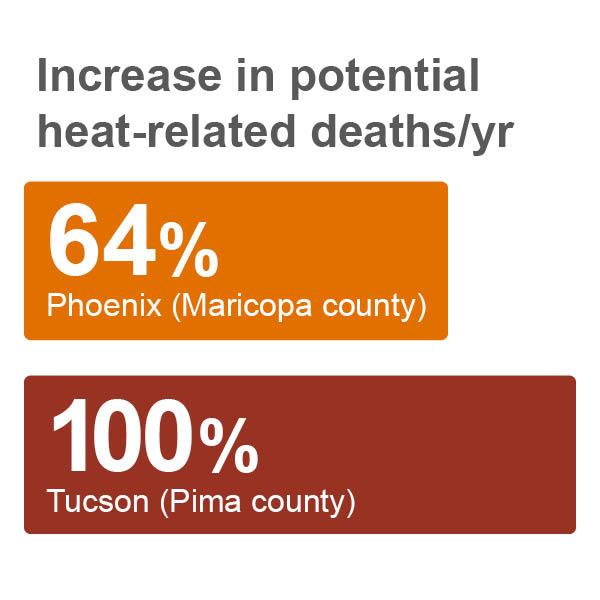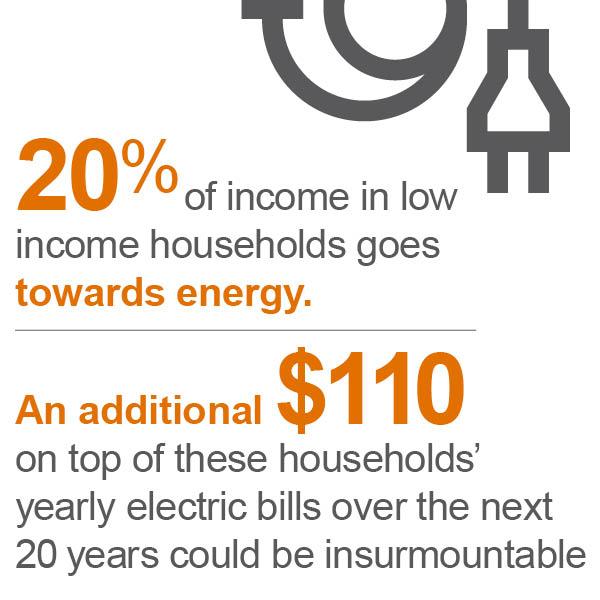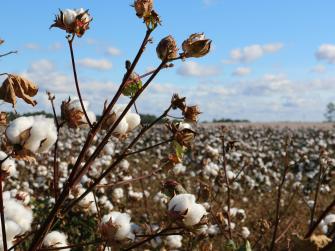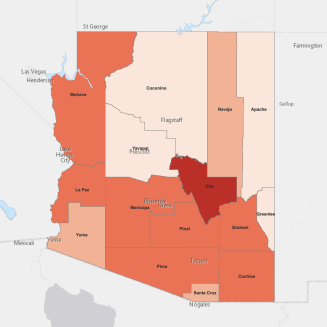Climate costs will strain Arizonans' health and economy

In Arizona, climate change is already making deadly heat waves, droughts and wildfires across the state worse. These effects of climate change have real costs on Arizonans’ health and economy, including heat-related deaths, higher electricity bills, crop losses and more.
And without action, these costs will only grow worse and further strain recovery from the COVID-19 pandemic, which has battered the Arizona economy and taken thousands of lives in the state.
EDF’s examination of local data reveals just how damaging not acting on climate will be to Arizonans in specific parts of the state.
Heat-related deaths expected to rise
Arizona is no stranger to the dangers of extreme heat, the most deadly weather-related phenomenon in the U.S. Phoenix and Tucson were ranked as two of the fastest-warming cities in the nation over the last five decades. For 144 days last year, Phoenix met or exceeded 100-degree temperatures, breaking a new state record.
Urban areas, like Phoenix and Tucson, are especially susceptible to rising temperatures from climate change, as dark pavement, buildings and other structures absorb heat and make temperatures even hotter – a phenomenon known as urban heat island effect. The effects can be deadly. Exposure to extreme heat can cause heat stroke and dehydration, among other serious issues.
The potential per year increase in heat-related deaths, based on 2019 mortality data from each county.

Collectively, Maricopa and Pima counties could see upwards of 120 additional deaths per 100,000 in the next 20 year period from extreme heat.
Maricopa county, home to Phoenix, could expect to see 56 additional heat-related deaths per 100,000 over the next 20 years — or a potential 64% increase in heat-related deaths every single year. And Pima county, where Tucson is located, could expect to see 64 additional heat-related deaths per 100,000 over that same period — or a potential doubling in heat-related deaths every single year.
Importantly, extreme heat will most impact those who are already at-risk. This includes populations that are uniquely susceptible to harm — including children, the elderly, people with existing conditions the sick, and those who lack access to air conditioning, often in low-income households.
Electricity bills will climb
As Arizonans seek cool shelter from the rising heat, electricity bills for households and businesses will climb. In Arizona, a quarter of the energy consumed by homes goes towards running an air conditioning unit – that's more than four times the national average in the U.S. Running the air conditioner, which could be considered an essential health service, becomes increasingly expensive for households with more extreme heat days.

More costly electricity bills will have a disproportionate impact on low-income households.
Over the next 20 years, residents could pay up to $110 of extra cost annually in electricity bills or $2,200 total added cost by 2040. Businesses could face a total added cost of over $5,500 by 2040 with unchecked climate change.
These added electricity costs will not be felt evenly. Lower-income households will be the most affected because they spend a higher proportion of their income on energy. Some 722,000 Arizona households with incomes lower than $30,000, allocate about 20% of their after-tax incomes to energy. For households like these, an additional $110 on top of yearly electricity bills over the next 20 years could prevent them from making ends meet on other essential needs.
Cotton production, an economic driver, will decline

Despite its Sonoran Desert location, Arizona is a leading producer of cotton. It can produce twice as much cotton per acre than cotton powerhouses like Texas and Georgia. Cotton is known as one of the state's 5 C's — Copper, Cattle, Cotton, Citrus and Climate — which have historically been key drivers in Arizona's economy. Today, cotton contributes about $400-500 million per year to Arizona's economy and about two-thirds of the state's production today is grown in Pinal, Maricopa, and Pima counties in central Arizona.
Cotton is extremely water intensive, which makes it a challenging crop for Arizona's hot and dry climate. In Pinal, Maricopa, and Pima counties, cotton requires roughly two to four times as much water per acre as in Texas and Georgia — a resource that is increasingly scarce as extreme heat and drought conditions become more frequent and severe.
Water scarcity in Arizona
Arizona gets nearly 40% of its water from the Colorado River, but water supply is diminishing from the growing demand of the more than 40 million people that rely on the river and from the impacts of climate change. The river's reservoirs have been historically low for the past two decades, and an estimated 20% drop in streamflow is expected in as soon as three decades, which could have severe consequences for water supply, economic activity and ecosystem health.
Another key source for rural cotton growers, groundwater, is also susceptible to increasing drought and demand. It will be further strained when the state must cut back on Colorado River water deliveries to Central Arizona through the Central Arizona Project, as required by the multi-state Drought Contingency Plan for managing historic drought conditions in the basin. Those cutbacks in surface water will build pressure for additional groundwater use by farmers from aquifers that are already at risk.
Crop yield declines
As the complications from water scarcity mount, counties in Arizona can expect agricultural yield losses — the amount of crop produced per acre of land — as high as 12% per year for the next 20 years. Depending on future prices and trade patterns, these could add up to crippling multimillion-dollar losses for the Arizonan cotton industry every year.
Pinal County is Arizona's largest cotton-producing county and ranks in the top 1% of counties in the nation for cotton and cotton-seed sales. Here, yields are expected to decline by about 10% annually for the next 20 years.
Maricopa county can also expect to see yields drop by 10% annually until 2040.
Beyond the direct losses to farmers, these yield declines could create a ripple effect across these counties, leading to local job losses and revenue decline for essential community services like schools and public safety.
Elected officials must act
The costs of climate inaction over the next 20 years make it clear: We need urgent action to stem the worst climate impacts on Arizonans. And these costs will only grow worse the longer we delay.
Elected officials in Arizona need to take immediate action to curb climate-warming pollution, build resilience and protect the most vulnerable communities. They can start now, while rebuilding a more sustainable and resilient economy for generations to come.












